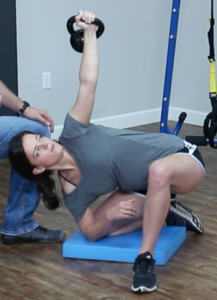by Mitch Hauschildt, MA, ATC, CSCS
Simply put, rotation is the forgotten plane of motion. It is incredibly important because it plays a role in virtually every movement pattern, yet it is rarely the focus of our attention. And, when it is the focus of attention (i.e. baseball, golf, volleyball, etc), it is likely only trained on one side, leading to asymmetries.
We can break down all movement into 5 basic areas:
- Squat
- Lunge
- Press
- Pull
- Rotate
Virtually all movement can be placed into one of these categories. For instance, walking is a variation of the lunge. Opening a door to enter a store is a variation of either the press or the pull, depending on which way the door swings. Jumping up to grab a rebound in a pickup game of basketball is a variation of the squat.
But, all of those examples have one thing in common. They all have a rotational component. If you are going to walk efficiently, you have to know how to resist bad rotation. Allowing your hips to swivel back and forth as you take steps will decrease your efficiency, slow you down and waste energy. When you do open that door, I guarantee you also reach and rotate as you either push or pull it open. And, when you jump up for the rebound, you have to know how to either create small levels of rotation or resist poor rotation to make sure that you take off and land with the accuracy that you need to get the rebound, avoid injuries and able to make the next play with the ball. Rotation plays an important role in all 5 of the basic movement patterns. It will affect performance.
Runners who have poor rotary stability tend to leak energy because they don’t have the pelvic stability to appropriately transfer force throughout the kinetic chain. Golfers, baseball players, tennis athletes, and others who participate in rotational sporting activities decrease their performance due to lack of rotational consistency and power development.
Poor rotation also has a large impact on injury rates. It is natural to consider injuries such as low back and hip pain with poor rotary stability. But, things like foot pain, shoulder issues, and extremity injuries can be directly connected back to poor rotation.
Why are we so bad at rotating?
- Rotation is Complex. Movement patterns that involve rotation are, by nature, rather complex. They almost always involve several joints working in unison with the proper timing, sequence and rhythm to work efficiently. If any of those joints are not working properly or appropriately coordinated by the nervous system, rotation is going to suffer.
- Rotation isn’t easily quantifiable. We like to see numbers. Especially if we are coaches. We love data. We allowed ourselves to be paralyzed by the data. We are trained to believe that if we see an improvement of just 5 pounds on a 1 rep max over a period of time is a sign of a successful training progam. This works well for exercises such as the bench press, back squat or deadlift, but it doesn’t work well for a Pallof press, cable chop or rolling pattern. Because of the complexity of these movements, they are very difficult to assess under a load. And, honestly, you wouldn’t want to try to assess them under a load because load is not an appropriate indication of the quality of the pattern. But, because we like to train things that we can assess objectively, we don’t focus much time on other things that we can’t quantify.
Because of these and other factors, a lot of our movement dysfunction lies in the transverse plane. Finding this dysfunction takes a keen eye and a quality assessment. But, a failure to find it and train it puts people at risk for injury and poor performance.
We are Designed to Rotate
Even though we are so poor at rotating, I firmly believe that we are designed to rotate. Through our functional and spiral fascial lines, we create power and precision. They are the body’s cheater systems, efficiently transferring force from the upper to the lower body and vice versa. They also happen to work in the transverse plane.
The Stecco family often talks about how our fascia wraps our extremities in a helical pattern, making rotating efficient and easy in the extremities. The body was truly created to rotate efficiently. It is our comfortable lifestyle that is jacking everything up.
It’s time to get back to basic fundamental movement patterns, including rotating efficiently and frequently. Lets work together to make an authentic, methodical movement of rotating efficiently.
Want to Learn More?
I’m excited to announce our latest project at Maximum Training Solutions…Training the 3D Human Machine. This project has been a long time coming and it is the biggest project to date. Within this video series (and accompanying manual), you will find everything you need to assess and train rotation properly.
Currently, we are putting the final finishing touches on everything and will be announcing the official launch date very soon (it won’t be more than a couple of weeks). Be on the look out for more information!


Exciting!!!